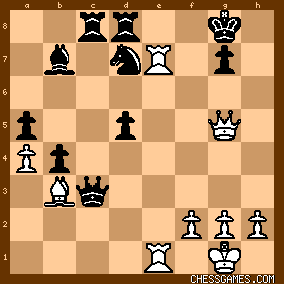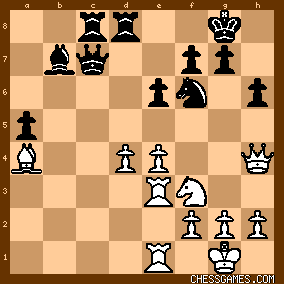| Feb-18-05 | | WMD: Fine played 17...Rfd8. |
|
| Jul-29-09 | | PeterB: Reuben Fine, to me, was a bit of an enigma. At his best, as in AVRO 1938, he was great, and then as here and in post-1945 games, he played rather weakly. In this game he seems to completely underestimate Keres' plan of pushing the e pawn to e5 and e6! |
|
| Jul-29-09 | | AnalyzeThis: I don't know. It's a tricky opening. Spassky beat Petrosian with a similar d5 push, except that the terrible pawn was a d pawn instead of an e pawn. (In fact, Petrosian was even ahead a pawn, but it didn't matter). I've taken black in similar Queen's Accepted positions againt the computer, and even with plenty of attention paid to the d5 square, the thing plays d5 and beats me anyway unless I'm extremely careful. Spassky vs Petrosian, 1969 |
|
| Jul-29-09 | | veigaman: What a pitty that keres changed his style! What a player in that time and also later. |
|
| Aug-02-09 | | birthtimes: Here's another wonderful illustration by Keres of Nimzowitsch's concept of overprotection. This time, by move 16, the strategically important e5 square is overprotected by White's queen, pawn, knight, and rook. Three moves later, White's other rook joins in on the fun! From this tremendous position of strength, White's two sham sacrifices result from "the form of a large radius of activity" for those pieces engaged in the overprotection of the e5 square. Truly, if pieces are are so engaged in overprotecting strategically important points, "they get their reward in the fact that they will then find themselves well posted in every respect." Today's tendency to downplay the importance of overprotection stems primarily from an inadequate and incomplete understanding of overprotection itself... |
|
| Aug-26-09 | | Crocomule: The white rooks on the e file aren't about "over-protection" at all; Keres was merely pursuing a faulty tactical ploy, and needed to remove a rook from d1. But, nontheless, it is an amazing game - and his first true masterpiece... |
|
| Aug-29-09 | | birthtimes: Crocomule, utilizing Nimzowitsch's concept, the white rooks are overprotecting in the way Nimzowitsch defined overprotection. Now, if you can find something by Nimzowitsch that counters this, then let us know. |
|
| Aug-29-09 | | AnalyzeThis: Overprotection has to do with building up on e5 to discourage a freeing idea such as f6. That wasn't what was happenning here. This was a king hunt. |
|
| Aug-29-09 | | birthtimes: As Nimzowitsch states, "strategically important points [such as e5], should be overprotected. If the pieces are so engaged, they get their reward in the fact that they will find themselves well posted in every respect...the reward came in the form of a large radius of activity for the pieces [so] engaged." |
|
| Aug-29-09 | | birthtimes: Here's another wonderful illustration by Keres of Nimzowitsch's concept of overprotection. This time, by move 16, the strategically important e5 square is overprotected by White's queen, pawn, knight, and rook. Three moves later, White's other rook joins in on the fun! From this tremendous position of strength, White's two sham sacrifices result from "the form of a large radius of activity" for those pieces engaged in the overprotection of the e5 square. Truly, as Nimzowitsch stated, if pieces are are so engaged in overprotecting strategically important points, "they get their reward in the fact that they will then find themselves well posted in every respect" (to then branch out into "the form of a large radius of activity" [such as a form of a king-side attack] i.e., 17. Qh4 23. Ng5 and 25. Rh3). Today's tendency to downplay the importance of overprotection stems primarily from an inadequate and incomplete understanding of overprotection itself... |
|
| Aug-31-09 | | Crocomule: After long thought white decided on the following plan. He would like to make a pawn sacrifice, by d5 and if then ed to continue the attack by e5. But this is not possible immediately, since after 18.d5, ed; 19.e5, black answers 19..Ne4 and if then white tries the intended exchange sacrifice by 20.Re4, de, then his rook on d1 is en prise and he cannot continue with 21.Ng5. Therefore, in preparation of this combination, white first removes his rook from the queen file. (Keres '64) |
|
| Aug-31-09 | | birthtimes: Yes, I know that Keres was not thinking about Nimzowitsch's overprotection concept when he was thinking about these moves, nor did he probably make the connection years after this game was over, yet it is still overprotection as defined by Nimzowitsch. This is crystal clear if one understands how Nimzowitsch defined overprotection, as mentioned above. But again, if you or anyone can find something that Nimzowitsch wrote that counters his previous statements that are listed above, feel free to let us know. |
|
| Sep-15-11 | | whiteshark: <23...h6> should hold the game.
click for larger viewe.g. <24.e6 hxg5 25. exf7+ Kxf7 26.Re7+ Kg8 27.Qxg5 Qc3> 
click for larger view |
|
| Sep-15-11 | | Kinan: What about 24.Nxf7 ? |
|
| Sep-16-11 | | whiteshark: <Kinan: What about 24.Nxf7 ?> After <24.Nxf7 Kxf7 25.e6+ Kg8 26.exd7 Rxd7> Black is a pawn up an White's initiative is coming to a stop. 
click for larger view |
|
Jun-09-13
 | | Tabanus: I added day and month to this game, based on Visir Sunnudagsblad (Iceland) 16 May 1937, p. 8 |
|
| Jun-09-13 | | RandomVisitor: After 17...Rfd8 there is 18.Ng5 h6 19.Nxe6! fxe6 20.Bxe6+ Kh7 21.Bxc8 Rxc8 |
|
| Jun-09-13 | | RandomVisitor: 20...bxa4 21.Bxa4 h6 and black is likely better |
|
| Jun-11-13 | | RandomVisitor: 20...bxa4 21.Bxa4 h6

click for larger view Rybka 4.1 x64:
[-0.80] d=23 22.h3 Ba8 23.Bb3 Rb8 24.e5 Nd5 25.Bxd5 Rxd5 26.Ra1 Rdb5 27.Kh2 Rb3 28.Qf4 R8b4 29.Rxb3 Rxb3 30.Nd2 Rb2 31.Nf1 Bb7 32.Ne3 [-0.99] d=23 22.Bb5 Ra8 23.Ra1 a4 24.Bf1 Ba6 25.Bxa6 Rxa6 26.e5 Nd5 27.Rea3 Rc8 28.Qe4 Rb6 29.h3 Rb4 30.Kh2 Qc4 31.Nd2 Qc2 [-1.01] d=23 22.Bd1 Ra8 23.Ba4 Rab8 24.Bd1 Ba8 25.Be2 a4 26.Bf1 Rb4 27.Ra1 Bb7 28.Bd3 a3 29.Bf1 Bxe4 30.Qg3 Qb7 31.Raxa3 Bxf3 [-1.05] d=23 22.d5 exd5 23.e5 Ne4 24.h3 Qc4 25.Bd1 Nc5 26.Qd4 Bc6 27.Rc3 Qxd4 28.Nxd4 Bd7 29.Ra3 a4 30.Bg4 Ne6 31.Nf5 Rc5 32.Nd6 Rb8 33.Rf3 Be8 34.Rd1 [-1.12] d=23 22.Rf1 Rb8 23.h3 Ba8 24.Bd1 Rb4 25.Be2 a4 26.Ra1 Bb7 27.Bd3 a3 28.Bf1 Bxe4 29.Qg3 Qxg3 30.fxg3 Bxf3 31.gxf3 g5 32.Rexa3 [-1.19] d=23 22.Kh1 Rb8 23.Bd1 Ba8 24.Rd3 a4 25.e5 Qc4 26.Ra3 Bxf3 27.exf6 Qb4 28.Rg1 Bxd1 29.Rg3 g6 30.Qxh6 Qf8 31.Qxf8+ Kxf8 32.Rxd1 Rxd4 33.Ra1 Rf4 34.Kg1 Rb2 35.Rf3 Rxf3 36.gxf3 Rb4 37.Rc1 |
|
| May-11-14 | | Prosperus: 31. ... dxe3 32. exf7+ and now:
32. ... Kd7 33. Qe6+ Kc7 (33. ... Kd8 34. Qd6#) 34. Rxc1+  32. ... Rxf7 33. Bxf7+! Kd7 (33. ... Kf8 34. Be6+ Ke8 35. Qf7+ Kd8 36. Qd7#) 34. Qe6+ Kc7 (34. ... Kd8 35. Qd6#) 35. Rxc1+  |
|
| Jul-25-16 | | andrea volponi: 22...Ce4!= |
|
| Mar-13-25 | | andrea volponi: 23...h6! -Nxf7!? =. |
|





